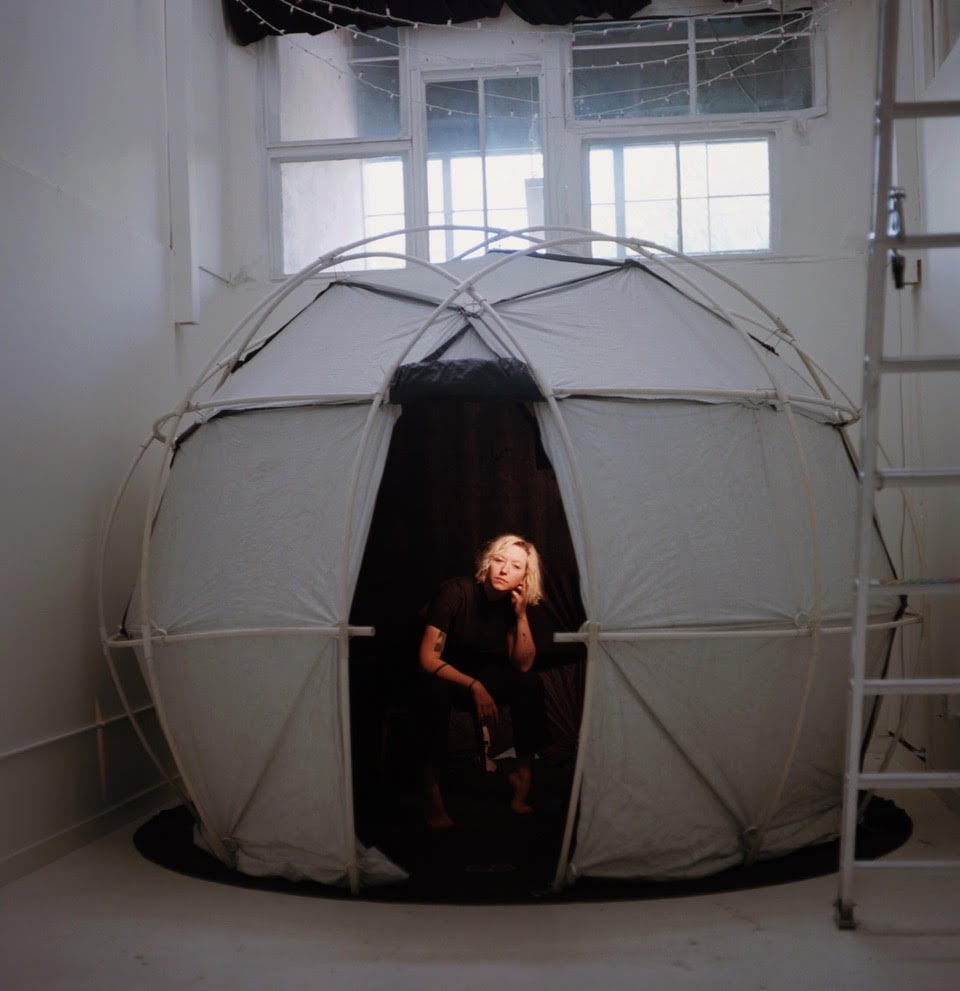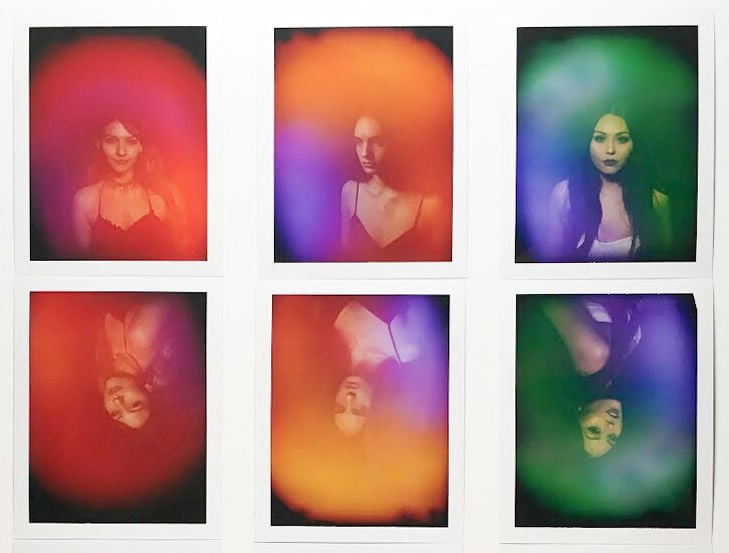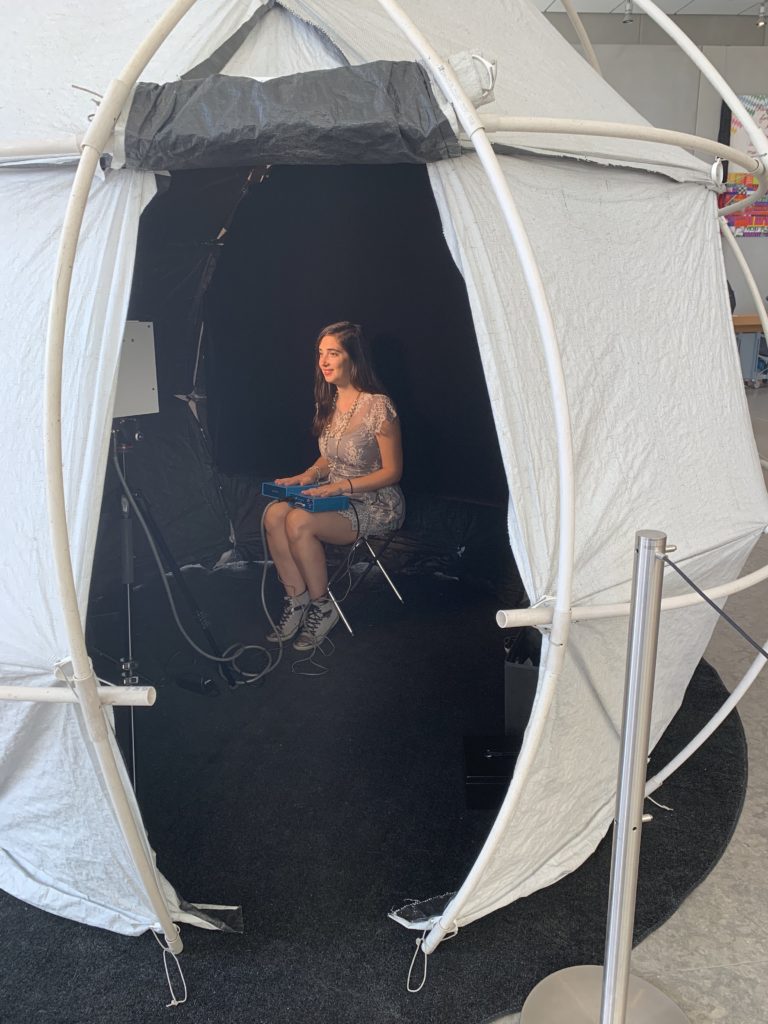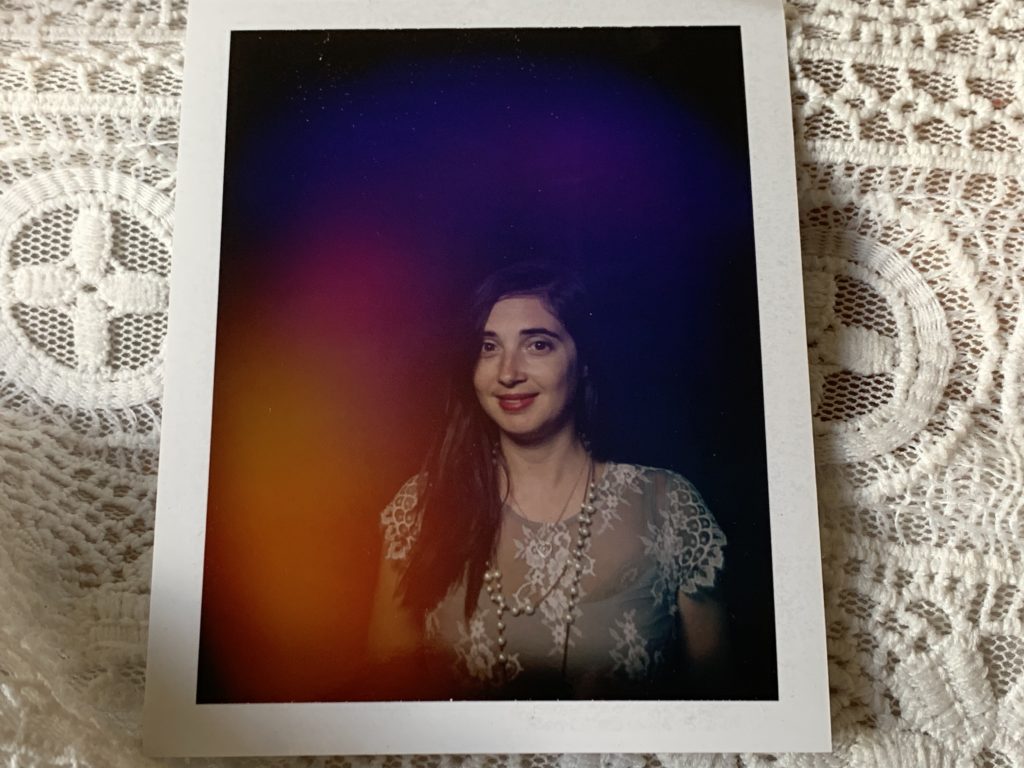On View
‘Our Energy Speaks First’: Meet the Artist Who Has Been Photographing Visitors’ Auras at the Whitney Museum
Discover what the artist Christina Lonsdale had to say about our reporter's electromagnetic energy.

Discover what the artist Christina Lonsdale had to say about our reporter's electromagnetic energy.

Sarah Cascone

For just $40, you can buy an original portrait at one of New York’s most prestigious museums. Since April, the artist Christina Lonsdale has been a fixture in the lobby of the Whitney Museum of American Art, capturing her subjects’ electromagnetic energy in colorful aura photographs.
The artist has been camped out at the Whitney Shop, quietly creating extraordinary portraits of visitors as part of her ongoing project Radiant Human. As her residency winds down, I visited the Whitney for an appointment to experience an aura reading of my own, eager to see how my own energy would manifest itself. (The artist and institution were reluctant to talk about the impact on the project of the Warren Kanders protests that have been taking place nearby.)
“As human beings, we carry electricity inside us,” Lonsdale said. “It radiates past our skin in what’s known as an electromagnetic field.”
She is able to capture that energy through two metal sensors. A specially designed, hand-modified Polaroid camera then analyzes the wavelengths of the subject’s electromagnetic energy. Using an algorithm, the camera translates those wavelengths into colors, which appear as an overlay printed on top of the normal photograph.
“It’s translating your energy into an aura, so we can see it,” Lonsdale explained. “It’s basically a filter—instead of doggie ears and Coachella wreathes, you have the color of your energy.”

Radiant Human aura photography by Christina Lonsdale. Photo courtesy of Radiant Human/the Whitney Museum of American Art.
Invented in the 1970s, the special aura camera has more traditionally been associated with psychic fairs, crystal shops, and New Age healing—there’s also a popular shop, Magic Jewelry, that does them down in New York’s Chinatown and out in Flushing, Queens.
Since the artist began Radiant Human six years ago, aura photography has become something of a social media phenomena—in November, the Ringer website published an article called “How Aura Photography Invaded Instagram,” accusing the photo-sharing platform of “stripping [the medium] of its ‘crunchiness’ and giving it a trendy new sheen.”
But Lonsdale is unconcerned that a quest for likes could overshadow the existential personal truth aura photography purports to represent. “This process is truly a representation of self, so I think you get what you put into it,” she said. “If you come with superficial intentions, you’re going to get a superficial outcome.”
Over the past six years she has captured around 39,000 people’s auras. Lonsdale works out of a portable domed tent, which creates a consistent environment for all her portraits. What sets Lonsdale apart from the typical aura photographer is that, as an artist, she is as interested in the picture of the subject as she is in the colorful overlay.

Sarah Cascone gets her aura photographed by Radiant Human’s Christina Lonsdale at the Whitney Museum of American Art. Photo by Mary Anne Stetts.
“Traditionally, the way that people use this camera, the image usually comes out really blurry. You can’t see your face. The photographers aren’t artists, and they aren’t interested on how you look in the image. They’re more focused on the color of the energy, so they can help guide you,” Lonsdale explained. “I wanted to give equal bandwidth to the physical body and the energetic body.”
Lonsdale is clear that she is not a faith healer or psychic. Each aura photograph comes with a list of possible meanings for the colors, but “it’s a crowd-sourced interpretation, not just my opinion,” she was quick to point out.
And other aura photographers aren’t typically invited to set up shop in art museums. Radiant Human’s first residency at the Whitney was for ten days back in 2016, then a long engagement for the itinerant artist. People have traveled across the country for the express purpose of having their portrait made. (A family of five flew in from San Jose, California, to the Whitney for their appointment.)
This time around, Radiant Human has been paired with the exhibition “Spilling Over: Painting Color in the 1960s” (through August 18), which includes Op art and Color Field paintings from the period in which acrylic paint was first being adopted.
“I felt like it was a natural fit, because of the work I’ve done discovering the relationship between color and energy,” said Lonsdale. “And I love the historical component—color became such a tool of expression in the ’60s.”
But the next time you see Lonsdale at a museum, it just might be in the galleries. Although her subjects typically take home their portraits because the camera can only print an image once, Lonsdale has begun taking two photos of each person on days she suspects will yield interesting results, such as during the Women’s March. Her 4,000-strong archive of aura photographs will be the subject of an upcoming book and, hopefully, an eventual exhibition.
“I’ve been holding off until I reached a body of work that I feel good about, and I’m at that point now,” she said.
The film Lonsdale uses is expensive, so she photographs herself relatively sparingly, perhaps 500 times in total. She finds that purple—often a manifestation of creativity—is a consistent presence in her aura, but that the colors change based on her mood and experiences in her day-to-day life.
While I’m no expert, I’d describe the artist’s energy as a calming one, setting her subject at ease as she angles them toward the camera, perhaps smoothing their hair or instructing them to raise their shoulders, or lower their chin.
When it comes to others, Lonsdale has noticed trends based on geography or life experience. New Yorkers, for instance, tend to have a lot of green, which can stand for long-term goals. And she has found that a hangover photographs similarly to depression.
“Our energy speaks first,” said Lonsdale. “When you walk into a room, people are already reading you—they can see if you’re in a good mood.” An aura photograph is a physical manifestation of established concepts, such as “weird vibes,” she added.

The author’s aura photograph from Radiant Human’s Christina Lonsdale, taken at the Whitney Museum of American Art. Photo by Sarah Cascone.
As for my aura, it was awash in orange and purple, with a blank spot on the lower right that Lonsdale said indicated that I “typically withhold energy to observe a scenario before you invest yourself into it.”
The orange, common in reporters, was a sign of creativity. “You’re resourceful and collaborative, and diplomatic, but also the smart kid in class,” said Lonsdale. “You need healthy challenges, or you will get bored and procrastinate.”
I asked her about a pink spot between the purple and orange fields. “You have magenta there,” Lonsdale noted. “That’s what makes you very stubborn sometimes.”
I had brought my mother along for the appointment. Laughing, she told Lonsdale, “I think you described her very accurately!”
Aura Photography by Radiant Human is appointment only at the Whitney Shop at the Whitney Museum of American Art, 99 Gansevoort Street, New York, April 3–August 5, 2019.